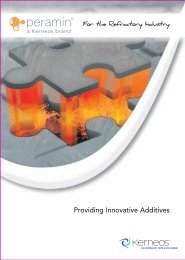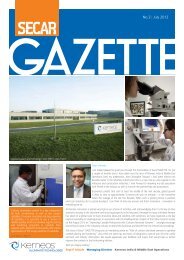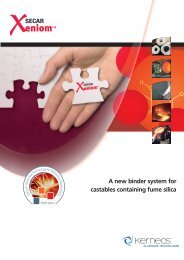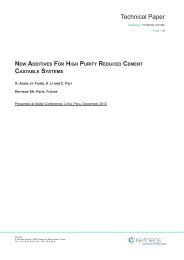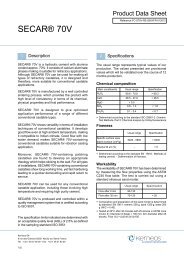Download the document - SECAR®, solutions for refractories
Download the document - SECAR®, solutions for refractories
Download the document - SECAR®, solutions for refractories
Create successful ePaper yourself
Turn your PDF publications into a flip-book with our unique Google optimized e-Paper software.
Technical Paper<br />
Reference : TP-GB-RE-LAF-090<br />
Page : 1/9<br />
A New Calcium Aluminate Cement resistant to Ageing<br />
C. Parr, H. Fryda, J. Mahiaoui, E. Larnaudie, E. Charpentier, M. Lievin.<br />
Kerneos SA, Paris, France<br />
Presented at Alafar Conference, Lima, Peru, December 2010<br />
Kerneos<br />
8, Rue des Graviers - 92521 Neuilly sur Seine Cedex, France<br />
Tel. : +33 1 46 37 90 00 - Fax : +33 1 46 37 92 00
Technical Paper<br />
Reference : TP-GB-RE-LAF-090<br />
Page : 2/9<br />
1 Introduction<br />
A key area <strong>for</strong> improvement of <strong>the</strong> reliability<br />
of deflocculated dense low calcium content<br />
castables (LCC) would be to increase <strong>the</strong>ir<br />
resistance to ageing and offer a much longer<br />
shelf-life. This would mean predictable placing<br />
properties irrespective of <strong>the</strong> storage time of<br />
<strong>the</strong> dry mix. ‘Ageing’ is a generic name used<br />
to describe interactions between a cement or a<br />
castable and <strong>the</strong> atmosphere, and <strong>the</strong> impact<br />
this interaction has on <strong>the</strong> cement reactivity<br />
and <strong>the</strong> castable properties as a function of dry<br />
mix storage time. Ageing manifests itself as a<br />
change in placing properties such as delayed<br />
hardening and demoulding times. Two steps<br />
can be described, namely, <strong>the</strong> ageing of <strong>the</strong><br />
calcium aluminate cement (CAC) when stored<br />
alone and <strong>the</strong> ageing after <strong>the</strong> CAC has been<br />
introduced into <strong>the</strong> dry castable mix. Previous<br />
studies [1,2,3] have shown that ageing of CAC in<br />
both steps, leads to a weight increase which<br />
can be characterised by an increase in <strong>the</strong> of<br />
Loss on Ignition (LOI), but, depending on <strong>the</strong><br />
period of ageing, <strong>the</strong> impact on <strong>the</strong> reactivity<br />
can be quite <strong>the</strong> opposite. The first period is a<br />
surface pick up of H 2<br />
O and CO 2<br />
which leads<br />
to a delay of dissolution of CAC, working time<br />
and demoulding time. The second period is<br />
characterised by a decrease of working time<br />
and <strong>the</strong> precipitation of hydrates. The presence<br />
of H 2<br />
O and CO 2<br />
can be due to residual moisture<br />
in <strong>the</strong> dry mix raw materials (CAC, alumina,<br />
additives, fume silica, aggregates etc.), humidity<br />
trapped in <strong>the</strong> bag during packing, or through<br />
penetration through <strong>the</strong> packaging materials.<br />
Thus, ageing is not just confined to a problem of<br />
packaging of ei<strong>the</strong>r <strong>the</strong> cement alone nor <strong>the</strong> dry<br />
mix. Real benefits could be offered to <strong>the</strong> users<br />
through <strong>the</strong> development of ‘time stable’ CAC<br />
products. When used in LCC products, <strong>the</strong>se<br />
CAC’s would provide more stable properties<br />
during storage and a longer shelf-life.<br />
The development of a clearer understanding<br />
of <strong>the</strong> underlying mechanisms has led to <strong>the</strong><br />
development of a new calcium aluminate<br />
cement. The new cement is much more resistant<br />
to ageing and offers an intrinsic solution in<br />
providing predictable placing properties <strong>for</strong><br />
LCC’s, and consequently extends <strong>the</strong> shelf-life.<br />
This paper presents results and analysis of<br />
different ageing experiments per<strong>for</strong>med under<br />
different conservation and climatic conditions,<br />
as well as different <strong>for</strong>mulations. Different<br />
testing conditions demonstrate <strong>the</strong> improved<br />
resistance to ageing that <strong>the</strong> new product can<br />
offer.<br />
2 Experimental procedure<br />
2.1 Material Details<br />
Two calcium aluminate binders have been<br />
used. A commercial reference product,<br />
Secar ® 71, based on 70% alumina (code CAC<br />
70) has been compared to a development<br />
product, PP134. The chemical, mineralogical<br />
and physical properties of <strong>the</strong>se two binders<br />
are shown in Table 1. CAC 70 has a mineralogy<br />
based upon calcium monoaluminate (CA) and<br />
calcium dialuminate (CA 2<br />
). PP134 is a new<br />
calcium aluminate cement produced through a<br />
specific processing step which yields a similar<br />
chemistry and mineralogy. The objective is to<br />
directly substitute <strong>the</strong> PP134 <strong>for</strong> <strong>the</strong> reference<br />
CAC 70 in a deflocculated LCC. PP134 has<br />
been designed to resist moisture and CO 2<br />
pick<br />
up from <strong>the</strong> atmosphere during storage of ei<strong>the</strong>r<br />
<strong>the</strong> cement alone or within a dry mix, and yet,<br />
to retain <strong>the</strong> normal hydraulic activity when<br />
water is added as <strong>the</strong> first step of <strong>the</strong> castable<br />
processing and installation.<br />
Kerneos<br />
8, Rue des Graviers - 92521 Neuilly sur Seine Cedex, France<br />
Tel. : +33 1 46 37 90 00 - Fax : +33 1 46 37 92 00
Technical Paper<br />
Reference : TP-GB-RE-LAF-090<br />
Page : 3/9<br />
Table 1 : Characteristics of <strong>the</strong> calcium<br />
aluminate cements<br />
Units<br />
CAC 70<br />
Typical analysis<br />
PP134<br />
Typical analysis<br />
Al 2<br />
O 3<br />
% 68.5 – 69.0 68.5 – 69.0<br />
CaO % 29.5 – 30.5 29.5 – 30.5<br />
SiO 2<br />
%
Technical Paper<br />
Reference : TP-GB-RE-LAF-090<br />
Page : 4/9<br />
3 Experimental results and<br />
discussions<br />
Figure 1 illustrates <strong>the</strong> typical impact of ageing<br />
on <strong>the</strong> hardening profile of <strong>the</strong> LCC1 castables<br />
as measured by <strong>the</strong> ultrasonic velocity over<br />
time.<br />
Working time (mins)<br />
600<br />
500<br />
400<br />
300<br />
200<br />
100<br />
5000<br />
0<br />
Time zero 2m CAC 4m CAC Time zero 2m LCC 4m LCC<br />
Ultrasound velocity (m/s)<br />
4000<br />
3000<br />
2000<br />
1000<br />
Ageing 7 days in thin layer at<br />
20°C and 70% r. h..<br />
0<br />
0 60 120 180 240 300 360 420 480 540 600 660 720 780<br />
Time (min)<br />
Fig. 1 : Effect of artificial ageing of LCC1<br />
with CAC 70 on <strong>the</strong> ultrasonic profile.<br />
The whole castable dry mix was spread in a<br />
thin layer and exposed to 70% r.h. at 20°C <strong>for</strong><br />
7 days. The ultrasonic velocity curve with time<br />
is typical of a LCC with silica fume and Na-TPP,<br />
and is characterised by two steps. The first step<br />
is due to CAC dissolution / castable flocculation<br />
and corresponds to <strong>the</strong> working time with about<br />
5 MPa in compressive strength. The second<br />
step is <strong>the</strong> massive precipitation of hydrates<br />
leading to real hardening, with compressive<br />
strength development above 10 MPa. Ageing<br />
typically leads to a delay of <strong>the</strong> first step, but<br />
<strong>the</strong> time between <strong>the</strong> first and second steps<br />
remains constant. This can be seen in Figure<br />
1 as <strong>the</strong> curve of <strong>the</strong> aged product has been<br />
shifted to <strong>the</strong> right but maintains <strong>the</strong> same<br />
profile. O<strong>the</strong>r properties like water demand,<br />
24h, 110°C or fired strengths, porosity etc. are<br />
not impacted by ageing, as long as <strong>the</strong> water<br />
addition remains <strong>the</strong> same.<br />
Fig. 2 : Effect of artificial ageing of LCC1<br />
with CAC 70 on <strong>the</strong> working time.<br />
The effect of <strong>the</strong> age of <strong>the</strong> CAC (from <strong>the</strong><br />
packing date) on <strong>the</strong> LCC working time has<br />
been evaluated. Samples of CAC 70 were<br />
taken and stored in sealed paper bags exposed<br />
to 70% r.h. at 20°C <strong>for</strong> 4 months. Bags were<br />
opened at 2 and 4 month intervals, <strong>the</strong> CAC 70<br />
mixed into a freshly batched LCC1 <strong>for</strong>mula and<br />
<strong>the</strong> working time evaluated. Similarly, <strong>the</strong> same<br />
CAC 70 was taken and batched into <strong>the</strong> LCC1<br />
dry mix and <strong>the</strong> whole dry mix was placed in<br />
sealed paper bags and stored <strong>for</strong> 4 months.<br />
The LCC1 dry mix was tested and <strong>the</strong> placing<br />
properties were evaluated at 2 and 4 months.<br />
The results are shown in Figure 2. The left<br />
hand graph shows <strong>the</strong> evolution of <strong>the</strong> working<br />
time of <strong>the</strong> LCC1 castable when <strong>the</strong> CAC 70 of<br />
different ages is placed in a fresh dry mix. The<br />
reference working time (60 mins) is measured<br />
at <strong>the</strong> time that <strong>the</strong> samples of CAC 70 were<br />
drawn from storage. The right hand graph<br />
shows <strong>the</strong> ageing of <strong>the</strong> whole mix (prepared<br />
using fresh CAC 70) and <strong>the</strong> whole dry mix was<br />
<strong>the</strong>n aged. At both 2 and 4 month intervals, <strong>the</strong><br />
working time is around 1.5 times longer in <strong>the</strong><br />
case of whole dry mix ageing relative to using a<br />
system where <strong>the</strong> cement has been aged alone.<br />
Kerneos<br />
8, Rue des Graviers - 92521 Neuilly sur Seine Cedex, France<br />
Tel. : +33 1 46 37 90 00 - Fax : +33 1 46 37 92 00
Technical Paper<br />
Reference : TP-GB-RE-LAF-090<br />
Page : 5/9<br />
The implications are that even with a “fresh”<br />
or well preserved CAC, ageing will still occur<br />
once <strong>the</strong> cement is placed in a dry mix where<br />
<strong>the</strong>re is ei<strong>the</strong>r residual moisture from <strong>the</strong> o<strong>the</strong>r<br />
components and / or exchange of moisture with<br />
<strong>the</strong> environment.<br />
With this in mind, fur<strong>the</strong>r tests were carried out<br />
comparing <strong>the</strong> reference product (CAC 70) with<br />
<strong>the</strong> development product PP134 via simulated<br />
ageing of <strong>the</strong> whole mix. In o<strong>the</strong>r words “fresh”<br />
samples were placed in <strong>the</strong> dry mix inside sealed<br />
bags which were <strong>the</strong>n placed in an environment<br />
of 70% r.h. at 20°C <strong>for</strong> periods up to 12 months.<br />
Vibration Flow (%)<br />
140<br />
120<br />
100<br />
80<br />
Time zero<br />
CAC 70 2 months<br />
PP134 2 months<br />
60<br />
PTT 800 mins<br />
40 PTT<br />
370<br />
PTT 475 mins<br />
20 mins<br />
0<br />
0 50 100 150 200 250 300 350 400<br />
Time (mins)<br />
Fig. 3 : Effect of artificial ageing on <strong>the</strong><br />
vibration flow.<br />
Both <strong>the</strong> reference CAC 70 and <strong>the</strong> new PP134<br />
product (Figure 3) display <strong>the</strong> same vibration<br />
flow decay at time zero, i.e. just after dry mix<br />
batching. After <strong>the</strong> dry mix has been stored <strong>for</strong> 2<br />
months, <strong>the</strong> flow profile of CAC 70 is significantly<br />
extended, as is <strong>the</strong> exo<strong>the</strong>rmic profile (PTT)<br />
relative to <strong>the</strong> starting point at time zero.<br />
The impact of ageing conditions on castable<br />
working time is shown in Figure 4. In both<br />
cases, a significant extension of <strong>the</strong> working<br />
time is observed relative to <strong>the</strong> improved shelflife<br />
of <strong>the</strong> product. The PP134 shows a small<br />
initial evolution between 0 and 2 months, and<br />
<strong>the</strong>n remains stable under <strong>the</strong> environmental<br />
conditions of <strong>the</strong> test. An explanation <strong>for</strong> <strong>the</strong><br />
leng<strong>the</strong>ning and <strong>the</strong>n decreasing working time<br />
of CAC 70 has been proposed in [1] and it has<br />
been suggested that <strong>the</strong> presence of hydrates<br />
accelerate <strong>the</strong> nucleation. However, <strong>the</strong> working<br />
time remains extended relative to time zero.<br />
The hardening profile has been determined<br />
using an ultrasonic technique and <strong>the</strong> resulting<br />
curves are shown in Figure 5 <strong>for</strong> <strong>the</strong> reference<br />
CAC 70 and Figure 4 <strong>for</strong> PP134. The first<br />
increase in ultrasonic velocity is associated with<br />
<strong>the</strong> end of working time and <strong>the</strong> transition from<br />
a liquid to a solid.<br />
Working time (min)<br />
450<br />
400<br />
350<br />
300<br />
250<br />
200<br />
150<br />
100<br />
50<br />
0<br />
CAC 70<br />
PP134<br />
0 2 4 8 10<br />
Ageing time (months)<br />
Fig. 4 : Effect of artificial ageing on <strong>the</strong><br />
working time.<br />
The shelf life stable calcium aluminate, PP134,<br />
shows a flow decay comparable with <strong>the</strong> initial<br />
profile and <strong>the</strong> extension of <strong>the</strong> exo<strong>the</strong>rmic<br />
profile is limited.<br />
Kerneos<br />
8, Rue des Graviers - 92521 Neuilly sur Seine Cedex, France<br />
Tel. : +33 1 46 37 90 00 - Fax : +33 1 46 37 92 00
Technical Paper<br />
Reference : TP-GB-RE-LAF-090<br />
Page : 6/9<br />
The second increase is associated with a gain<br />
in mechanical strength as <strong>the</strong> hydration process<br />
develops to <strong>for</strong>m hydrates. In <strong>the</strong> case of <strong>the</strong><br />
reference, CAC 70, an initial shift in <strong>the</strong> hardening<br />
profile is noted after only two months storage, with<br />
<strong>the</strong> ageing of <strong>the</strong> whole mix being more affected<br />
than <strong>the</strong> case of ageing <strong>the</strong> cement alone. A<br />
fur<strong>the</strong>r extension is noted after 4 months. At this<br />
time, <strong>the</strong>re is also a change to <strong>the</strong> shape of <strong>the</strong><br />
curve indicating a slower hardening kinetic. This<br />
is particularly noticeable in <strong>the</strong> case of 4 months<br />
ageing of <strong>the</strong> whole castable mix. In practical<br />
terms, this would translate into an extension of<br />
400 to 500 minutes in <strong>the</strong> demoulding time. The<br />
improved time stable development product is<br />
able to maintain a very similar hardening profile,<br />
independent of <strong>the</strong> ageing conditions, and <strong>the</strong><br />
initial rise is centred around 200 mins with <strong>the</strong><br />
second increase at 500 mins. There is an initial<br />
shift from time zero i.e. wet mixing straight after<br />
batching and <strong>the</strong> first evaluation at 2 months,<br />
but <strong>the</strong>reafter <strong>the</strong> hardening profile remains<br />
remarkably constant.<br />
These profiles have been confirmed via <strong>the</strong><br />
measurement of early age mechanical strength<br />
at 6 hours from casting after ageing at 20°C and<br />
70% r.h. of <strong>the</strong> whole dry mix (castable stored<br />
in paper sacks <strong>for</strong> up to 12 months after dry<br />
batching). Hardening becomes so extended<br />
in <strong>the</strong> model LCC1 system prepared with <strong>the</strong><br />
reference CAC 70 after just two months that<br />
6 hour strengths can no longer be measured.<br />
In contrast, PP134 delivers consistent 6 hour<br />
strengths even after ageing <strong>for</strong> 12 months.<br />
There is a slight decrease from <strong>the</strong> initial values<br />
of 8 to 10 MPa but <strong>the</strong>n <strong>the</strong> strength remains<br />
stable around 6 MPa. There<strong>for</strong>e, <strong>the</strong> physical<br />
effects of ageing can be seen to be an extension<br />
of <strong>the</strong> working time (longer flow period),<br />
slower hardening and a delayed acquisition of<br />
mechanical resistance. The PP134, offering<br />
an intrinsic improvement to shelf-life, is able to<br />
ensure much more stable placing and hardening<br />
properties over <strong>the</strong> ageing period.<br />
12<br />
Velocity m/s<br />
5000<br />
4000<br />
3000<br />
2000<br />
Ref CAC 70<br />
2m -PP134<br />
4m -PP134<br />
4m -CAC 70<br />
2m -CAC 70<br />
CCS 6 hours (MPa)<br />
10<br />
8<br />
6<br />
4<br />
2<br />
CAC 70 PP 134<br />
1000<br />
0<br />
0 1 2 4 8 10 12<br />
0<br />
0 200 400 600 800 1000<br />
Time (min)<br />
Fig. 5 : Effect of artificial ageing on <strong>the</strong><br />
ultrasonic profile.<br />
Months of ageing<br />
Fig. 6 : Effect of artificial ageing on <strong>the</strong> early<br />
strength development of LCC1.<br />
Kerneos<br />
8, Rue des Graviers - 92521 Neuilly sur Seine Cedex, France<br />
Tel. : +33 1 46 37 90 00 - Fax : +33 1 46 37 92 00
Technical Paper<br />
Reference : TP-GB-RE-LAF-090<br />
Page : 7/9<br />
Properties of both CAC types were compared<br />
in a conventional castable to demonstrate that<br />
<strong>the</strong>y have equivalent behaviour in terms of a<br />
hydraulic binder, and that <strong>the</strong> development<br />
product PP134 will deliver equivalent installed<br />
characteristics to <strong>the</strong> reference system. 8%<br />
water was used in both cases and <strong>the</strong> tests<br />
were per<strong>for</strong>med at 20°C with “freshly” batched<br />
castable. The results <strong>for</strong> conventional castable<br />
are shown in Table 3 and confirm that both<br />
CAC’s behave in a similar way when applied to<br />
classical refractory systems.<br />
Table 3 : Conventional castables<br />
Units CAC 70 PP134<br />
Flow at t0 % 110 105<br />
CCS after 24 MPa 67.1 70.3<br />
CCS after 110°C MPa 97.1 101.3<br />
CCS after 600°C MPa 93.9 74.7<br />
CCS after 1350°C MPa 50.8 48.0<br />
CCS after 1550°C MPa 48.3 41.0<br />
BD after 110°C g/cm 3 2.88 2.88<br />
BD after 600°C g/cm 3 2.78 2.77<br />
BD after 1100°C g/cm 3 2.74 2.71<br />
BD after 1350°C g/cm 3 2.73 2.72<br />
BD after 1550°C g/cm 3 2.73 2.73<br />
AP after 110°C % 14.9 14.6<br />
AP after 600°C % 15.5 17.0<br />
AP after 1100°C % 23.5 22.6<br />
AP after 1350°C % 22.4 22.3<br />
AP after 1550°C % 23.4 23.1<br />
PLC to 600°C % -0.09 -0.09<br />
PLC to 1100°C % -0.07 0.30<br />
PLC to 1350°C % -0.17 0.05<br />
PLC to 1550°C % -0.08 -0.06<br />
The physical properties as measured by<br />
compressive strength, bulk density, apparent<br />
porosity and permanent linear change are<br />
similar <strong>for</strong> both CAC 70 and PP134.<br />
The evolution of LOI has been followed over<br />
a period of ageing (sealed bags 70% r.h. and<br />
20°C) <strong>for</strong> <strong>the</strong> calcium aluminate alone to give<br />
a confirmation that <strong>the</strong> effects observed in<br />
terms of LCC behaviour are linked to <strong>the</strong> same<br />
mechanisms as reported in [1] . It can clearly be<br />
seen (Figure 7) that <strong>the</strong> PP134 is much more<br />
resistant to LOI gain than <strong>the</strong> reference CAC 70.<br />
An initial increase of around 0.1% is observed<br />
<strong>for</strong> <strong>the</strong> first few days and <strong>the</strong>reafter <strong>the</strong> value<br />
remains constant. In comparison, <strong>the</strong> reference<br />
product CAC 70 shows an almost exponential<br />
growth in LOI over <strong>the</strong> 10 months. Coherent<br />
with <strong>the</strong> explanations reported in [1] , lumps were<br />
found in <strong>the</strong> CAC 70 after 10 months of ageing.<br />
(It should be pointed out that this is a laboratory<br />
evaluation. Under standard industrial packing<br />
conditions, with <strong>the</strong> additional protection of<br />
shrinkwrap layers, <strong>the</strong> product remains stable<br />
over 12 months.) This is linked to <strong>the</strong> second<br />
period of ageing characterised by a decrease of<br />
working time and <strong>the</strong> precipitation of hydrates.<br />
The change in LOI illustrates <strong>the</strong> intrinsic<br />
protection af<strong>for</strong>ded by <strong>the</strong> development product.<br />
Kerneos<br />
8, Rue des Graviers - 92521 Neuilly sur Seine Cedex, France<br />
Tel. : +33 1 46 37 90 00 - Fax : +33 1 46 37 92 00
Technical Paper<br />
Reference : TP-GB-RE-LAF-090<br />
Page : 8/9<br />
LOI (%)<br />
2.5<br />
2<br />
1.5<br />
1<br />
0.5<br />
0<br />
PP134<br />
CAC 70<br />
0 2 4 6 8 10 12<br />
Ageing time (months)<br />
Fig. 7 : Moisture pick-up as a function of<br />
ageing time <strong>for</strong> <strong>the</strong> two calcium aluminate<br />
cements.<br />
A fur<strong>the</strong>r evaluation of <strong>the</strong> intrinsic ageing<br />
protection af<strong>for</strong>ded by <strong>the</strong> time stable PP134 is<br />
illustrated in Figure 8. Samples of each cement<br />
type were exposed in a thin layer to 100%<br />
relative humidity at 20°C. Due to <strong>the</strong> extreme<br />
nature of this test, samples were only exposed<br />
<strong>for</strong> up to 24 hours. Under <strong>the</strong>se conditions, <strong>the</strong><br />
ageing is very quick.<br />
As can be seen from Figure 8, when <strong>the</strong> cement<br />
is placed in a ‘freshly’ mixed castable <strong>the</strong> working<br />
time is extended to more than 300 minutes<br />
after only 8 hours of ageing. Additional ageing<br />
results in a reduction of <strong>the</strong> working time to a<br />
value shorter than <strong>the</strong> initial value (i.e. be<strong>for</strong>e<br />
exposure to a high humidity). The LOI at 2.54%<br />
is indicative of hydrates being <strong>for</strong>med. This is <strong>the</strong><br />
same phenomenon that is previously described<br />
in that extreme ageing leads to <strong>for</strong>mation of<br />
hydrates and reduction of working time.<br />
Fig. 8 : Working time and LOI as a function<br />
of ageing at 100% r.h.<br />
This is in sharp contrast to <strong>the</strong> results <strong>for</strong> <strong>the</strong><br />
development product shown on <strong>the</strong> right hand<br />
side of Figure 8. Under <strong>the</strong>se extreme conditions,<br />
<strong>the</strong>re is a gradual and progressive increase<br />
in working time to 156 minutes after 24 hours.<br />
However, <strong>the</strong> LOI increase remains limited<br />
to 1.3%. This shows <strong>the</strong> intrinsic protection<br />
af<strong>for</strong>ded by <strong>the</strong> processing of PP134 which<br />
limits <strong>the</strong> destruction of <strong>the</strong> calcium aluminate<br />
hydraulic properties even at 100% r.h.<br />
Kerneos<br />
8, Rue des Graviers - 92521 Neuilly sur Seine Cedex, France<br />
Tel. : +33 1 46 37 90 00 - Fax : +33 1 46 37 92 00
Technical Paper<br />
Reference : TP-GB-RE-LAF-090<br />
Page : 9/9<br />
4 Conclusions<br />
The effect of ageing has been simulated<br />
through accelerated ‘artificial’ ageing tests and<br />
<strong>the</strong>se have shown <strong>the</strong> dramatic changes that<br />
can occur to castable placing and hardening<br />
properties. From a practical point of view, this<br />
will result in variability and unpredictability<br />
on site depending on <strong>the</strong> freshness of <strong>the</strong> dry<br />
mix castable. The demoulding times would be<br />
difficult to predict depending upon <strong>the</strong> storage<br />
history of <strong>the</strong> castable. The observed effects<br />
occur irrespective of storage time and storage<br />
conditions of <strong>the</strong> CAC alone.<br />
Through <strong>the</strong> specific processing of a new<br />
calcium aluminate, development product<br />
PP134, is able to offer robust placing properties,<br />
resistant to ageing effects, irrespective of<br />
whe<strong>the</strong>r <strong>the</strong> cement is stored alone or <strong>the</strong> whole<br />
dry mix is aged. Once mixed with water as part<br />
of a dry LCC mix, <strong>the</strong> reactivity of <strong>the</strong> PP134<br />
as a hydraulic binder is similar to <strong>the</strong> reference<br />
system and no major differences are seen in<br />
ei<strong>the</strong>r placing or placed properties. This should<br />
provide value to users in terms of both additional<br />
storage stability of <strong>the</strong> cement alone and, more<br />
importantly, a much more time stable dry mix<br />
which would lead to less site problems linked to<br />
<strong>the</strong> effects of castable ageing.<br />
6 References<br />
[1] Fryda H, Mahiaoui J, Larnaudie E,<br />
Charpentier E, Lievin M, Parr C. A new<br />
insight into <strong>the</strong> characterization of ageing<br />
and mechanisms that determine <strong>the</strong> shelf<br />
life of low cement castables. UNITECR<br />
2009, Salvador, Brazil.<br />
[2] Parr C, Revais C, Bunt N, Jones D, Bennet<br />
M. Ageing of Low Cement Castables.<br />
UNITECR 1997, New Orleans, USA: 81- 89.<br />
[3] Mathieu A, Bayoux JP, Vialle M. Ageing of<br />
Aluminous Cement in LCC. UNITECR 1995,<br />
Kyoto, Japan: 451 – 455.<br />
[4] Alt C, Wong L, Parr C. Measuring castable<br />
rheology by exo<strong>the</strong>rmic profile. Refractories<br />
applications; 8 (2): 15-18.<br />
[5] Simonin F, Wöhrmeyer C, Parr C. A new<br />
method <strong>for</strong> assessing Calcium Aluminate<br />
Cements. UNITECR 2005, Orlando, USA.<br />
5 Acknowledgements<br />
The authors would like to thank all <strong>the</strong> technicians<br />
and engineers at <strong>the</strong> Kerneos Research Centre<br />
<strong>for</strong> <strong>the</strong>ir excellent support during this study &<br />
associated development projects.<br />
Kerneos<br />
8, Rue des Graviers - 92521 Neuilly sur Seine Cedex, France<br />
Tel. : +33 1 46 37 90 00 - Fax : +33 1 46 37 92 00



